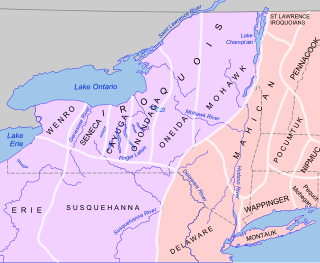
Back Сенека (мова) Byelorussian Llengua seneca Catalan Сенека (чĕлхе) CV Seneka lingvo Esperanto Seneka keel Estonian Senecan kieli Finnish Seneca (langue) French Lingua seneca Galician Lingua seneca Interlingua Lingua seneca Italian
| Seneca | |
|---|---|
| Onöndowaʼga꞉ʼ Gawë꞉noʼ | |
| Native to | United States, Canada |
| Region | Western New York and the Six Nations Reserve, Ontario |
| Ethnicity | Seneca |
Native speakers | 100 (2007)[1] |
Iroquoian
| |
| Language codes | |
| ISO 639-3 | see |
| Glottolog | sene1264 |
| ELP | Seneca |
 Map of the New York tribes before European arrival, showing the pre-contact distribution of Seneca in western New York
| |
 Seneca is classified as Severely Endangered by the UNESCO Atlas of the World's Languages in Danger | |
Seneca (/ˈsɛnəkə/;[2] in Seneca, Onöndowaʼga꞉ʼ Gawë꞉noʼ, or Onötowáʼka꞉) is the language of the Seneca people, one of the Six Nations of the Hodinöhsö꞉niʼ (Iroquois League); it is an Iroquoian language, spoken at the time of contact in the western part of New York.[3] While the name Seneca, attested as early as the seventeenth century, is of obscure origins, the endonym Onödowáʼga꞉ translates to "those of the big hill."[3] About 10,000 Seneca live in the United States and Canada, primarily on reservations in western New York, with others living in Oklahoma and near Brantford, Ontario. As of 2022, an active language revitalization program is underway.[4]
- ^ Seneca at Ethnologue (18th ed., 2015) (subscription required)
- ^ Bauer, Laurie (2007). The Linguistics Student's Handbook. Edinburgh.
{{cite book}}: CS1 maint: location missing publisher (link) - ^ a b Chafe 2015, p. 1.
- ^ Evans, Noelle E.C. "Seneca people are reviving their language, which boarding schools tried to erase". NPR. Retrieved November 4, 2023.
© MMXXIII Rich X Search. We shall prevail. All rights reserved. Rich X Search